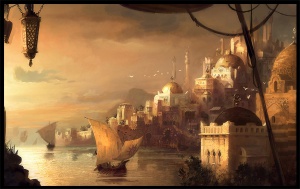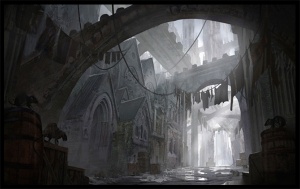D&D 5E: Fall of the Feywild - Setting Features
GEOGRAPHY[edit]
The Shattered Coast[edit]
The Shattered Coast is a long stretch of crumbling cliffs that stretches from the northernmost expanse of the Great Desert in the south, along the entire length of the Sundered Steppe, on into the Broken Lands of the far north. The Shattered Coast represents the easternmost boundary of the Dwarven Empire.
- Treacher's Deep: The inner sea, between the Near Isles and the Shattered Coast is a deep trench with a near constant glass-like surface.
- The Near Isles: Just off the shattered coast, nearly along its entire length, halfway to the horizon, is a scattered archipelago known as the Near Isles. The Near Isles are home to the Fjorn, a race of elemental giants who trade with the Dwarven Empire.
- Dragon's Reach: The Northern and Southern ends of the Near Isles devolve into miles of small islets of nearly uninhabitable rock, both of which are nigh infested with clutches of young dragons of every type.
- The Great Desert: Most of the Great Desert stretches to the south and west of the Shattered Coast but is still claimed as part of the Dwarven Empire by treaty with the Dragonborn and Tiefling nations.
- The Ferrous Wastes: The Ferrous Wastes are an ore rich mesa land given by treaty to the Tiefling by the Dragonborn in the distant past.
- Adamalasha: Seaside Tiefling city on the eastern edge of the Ferrous wastes at the southern edge of the Great Desert.
- The Hartshorn Mountains: The Hartshorn is a vast mountain range that borders the Great Desert to the north and sweeps up against the western edge of the Sundered Steppe, nudging hard against the Shattered Coast itself between those two landmarks.
- The Thundering Plain: Between the Great Desert and the Broken Lands is a great grassland, the southernmost portion of which is known as the Thundering Plain and is home to the nomads of the wandering Elven Nation.
- The Clanlands of the Sundered Steppe: The grasslands to the north are rougher and poorer lands and are the domain of the Barbarian Clans.
- The Broken Lands: Far north of the Steppes is the cracked and broken wasteland of the far north. Little if anything lives here.
Bar Kesh: City of Swords[edit]
Located on a protected harbor at the apex of the northernmost reach of the Great Desert, the easternmost reach of the Hartshorn Mountains, and the southernmost tip of the Thundering plains, Bar Kesh, City of Swords straddles major trade routes between the southern caravans of the desert and the nomadic elves of plain as well as being a major trade port between the Dwarven Empire and the Elemental Giants of the Near Isles.

- Rattown Wharves: The Wharves are the lowest point in Bar Kesh and home to its poorest denizens and dispossessed. Rattown is the portion of the city most likely to succumb to seasonal flooding. The Catspaw, or the Grey Watch, are responsible for keeping the peace in Rattown.
- Guardian's of the Deep: At either end of the c-shaped protected harbor is a lighthouse to guide ships through the stone narrows that are the only approach to the city from seaward.
- Fisher's Bazaar: Fisher's Bazaar is a flotilla of rafts and skiffs tied to one another in an awkward cluster for the purpose of selling fish, seaweeds, rope, nets, sailcloth, and other sea-needy fare.
- Merchant's Rim: Hard against the Hammerwall on the inland most side of the Wharves are the warehouses for imported and exported goods.
- The Shipyard: In the southernmost corner of the wharves is the shipyard for the repair and building of ships.
- The Hammerwall: The Hammerwall is an extension of the landward outer walls of the city, cutting in between wharves and city proper and acting as a seawall against flooding.

- The Labyrinth: The Labyrinth occupies the southernmost section of the city between the hammerwall and the westernmost outer wall. It has long since outgrown the ability to sprawl horizontally, and now mostly grows as it can, with streets suddenly becoming home to a new building even as another building is torn down to make a new way through. The labyrinth is always changing and is known as the Human Quarter.
- St. Michael's Bazaar: The unchanging hub at the center of the ever changing Labyrinth, St Michael's Bazaar is an open market of stalls and booths and tents where literally anything can be had if you know who to ask and have the sovereigns to pay.
- The Old City: In the easternmost corner of the Labyrinth lies the Old City, the original streets and stones of Bar Kesh. Built in scale to house Dwarves in the original city, mostly halflings dwell there now as the buildings were made of whole slabs of near indestructible stone rather than smaller cut stones easily moved.
- The Menhir: Ancient standing stones outside the Old City, the Menhir hold the first graves of Bar Kesh.
- The Catacombs: Beneath the Labyrinth and a portion of the Iron Quarter are the old sewer tunnels of the early city.
- The Iron Quarter: Newer and better built and more open than the Labyrinth, the Iron Quarter is home to the Dwarven Guard, the Smithing Guild, and most of the Dragonborn who dwell within the city walls. The Iron Quarter and the Walls of Bar Kesh are warded by the Black Watch.
- The Gold Quarter: Primarily reserved for the well to do of Dwarven society and the Tiefling Parliament. The Bloodguard, or Red Watch, are responsible for keeping the peace in the Golden Quarter.
- Jade Citadel: Dwarven seat of power, home of the five High Houses: House d'Ruvyen, House d'Amasku, House d'Szaar, House d'Meisha, and House d'Braeq.
- The Greensward: The Greensward is a parkland between the Iron and Gold Quarters and the few elves who make their home in Bar Kesh dwell here.
POLITICS[edit]
This setting does not follow the human-centric fantasy trope typically put forth for D&D. This particular corner of the world is occupied primarily by the Dwarven Empire with politically allied nations to the south (Tiefling and Dragonborn) and to trade allied nations to the east (the Fjorn, elemental giants of the Near Isles). Within their borders tribes of gnomes, men, halflings, and even elves may be found.
Dwarves[edit]
Due primarily to their longevity coupled with a vast impulse for both industry and trade, the Dwarven nation became the emergent power in the land centuries before. Five High Houses jointly rule the Dwarven Nation. House d'Ruvyen's demesne is Trade, House d'Amasku's demesne is Craft, House d'Szaar's demesne is Resources, House d'Meisha's demesne is Planning, and House d'Braeq - least of the dwarven high houses - is tasked with the duty of War.
Gnomes[edit]
Gnomes have a close bond with Dwarves and may be found scattered throughout the empire in small industrious communities. Gnomes are the only non-dwarf race whose disputes are governed directly by Dwarven rule and not by the Tiefling Parliament.
Dragonborn[edit]
The treaty with the Dragonborn is the oldest of Dwarven alliances, and is mostly concerned with raw mineral rights and term-soldiers from among the Dragonborn in exchange for finished goods. The Dragonborn are otherwise the uncontested nomadic masters of the Great Desert and maintain their own alliances both with the Tieflings and the Elves.
Tiefling[edit]
While the Dwarves recognize the economical benefit of their own empire, they have little interest in ruling peoples of other races who dwell within their empire and maintain their treaties with the Tieflings to avoid having to do so. Instead, a Tiefling Parliament is established in every Dwarven city and town big enough to merit one, and Tiefling Circuit Judges ride the roads to those villages and towns not big enough to merit the structure of a full Parliament.
The judges and parliaments do not make laws or even particularly enforce them so much as adjudicate between parties to settle disputes throughout the land.
Tieflings are not out to secure a solid power base so much as they take advantage of their position between parties and factions to gain vital information and leverage where it might benefit them.
Humans[edit]
The shortest lived of the races, but vastly prolific, humans often find themselves in the middle of things. Humans are the primary providers of farmed and husbanded and hunted and fished foods throughout the land, but also take hire in Dwarven mines or indenture themselves in the guilds in hopes of coming out as qualified tradesmen if not masters of a trade in their own right.
Humans are also the primary laborers at sea and ashore, though coastal Dwarves are master sailors and shipbuilders and often fill the highest positions on most seafaring vessels.
Halflings[edit]
Halflings typically make their dwellings near the habitation of humans and work well with and around them. they have little interest in treaties of any kind and tend to take joy in hearth and home above all.
Fjorn[edit]
The elemental giants of the Near Isles have trade agreements with the empire, but mostly remain in their isles.
Elves[edit]
Elves are mostly nomadic by nature for the first several hundred years of life, only settling in the misty lands beyond the mountains as they approach their thousandth year. Elves have no formal treaties with the Dwarves or any other nation and can be found in small groups throughout the empire and in larger traveling groups across the Thundering Plain.
Half Elves[edit]
Half Elves are rare in the land and do not usually have their own communities beyond the occasional coterie that might be found in larger Dwarven cities.
Half Orcs[edit]
Like Half Elves, Half Orcs are rare in the land, but are more likely to gather in bands and small tribes.